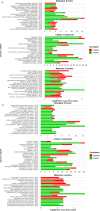Metabolic and transcriptomic study of pennycress natural variation identifies targets for oil improvement
- PMID: 37335591
- PMCID: PMC10440992
- DOI: 10.1111/pbi.14101
Metabolic and transcriptomic study of pennycress natural variation identifies targets for oil improvement
Abstract
Pennycress (Thlaspi arvense L.), a member of the Brassicaceae family, produces seed oil high in erucic acid, suitable for biodiesel and aviation fuel. Although pennycress, a winter annual, could be grown as a dedicated bioenergy crop, an increase in its seed oil content is required to improve its economic competitiveness. The success of crop improvement relies upon finding the right combination of biomarkers and targets, and the best genetic engineering and/or breeding strategies. In this work, we combined biomass composition with metabolomic and transcriptomic studies of developing embryos from 22 pennycress natural variants to identify targets for oil improvement. The selected accession collection presented diverse levels of fatty acids at maturity ranging from 29% to 41%. Pearson correlation analyses, weighted gene co-expression network analysis and biomarker identifications were used as complementary approaches to detect associations between metabolite level or gene expression and oil content at maturity. The results indicated that improving seed oil content can lead to a concomitant increase in the proportion of erucic acid without affecting the weight of embryos. Processes, such as carbon partitioning towards the chloroplast, lipid metabolism, photosynthesis, and a tight control of nitrogen availability, were found to be key for oil improvement in pennycress. Besides identifying specific targets, our results also provide guidance regarding the best timing for their modification, early or middle maturation. Thus, this work lays out promising strategies, specific for pennycress, to accelerate the successful development of lines with increased seed oil content for biofuel applications.
Keywords: Thlaspi arvense; biomass; embryo; jet fuel; metabolomics; transcriptomic.
© 2023 The Authors. Plant Biotechnology Journal published by Society for Experimental Biology and The Association of Applied Biologists and John Wiley & Sons Ltd.
Conflict of interest statement
The authors declare no conflict of interest.
Figures







References
-
- Alexa, A. , Rahnenführer, J. and Lengauer, T. (2006) Improved scoring of functional groups from gene expression data by decorrelating GO graph structure. Bioinformatics, 22, 1600–1607. - PubMed
-
- Allen, D.K. , Ohlrogge, J.B. and Shachar‐Hill, Y. (2009) The role of light in soybean seed filling metabolism. Plant J. 58, 220–234. - PubMed
-
- Almagro Armenteros, J.J. , Sønderby, C.K. , Sønderby, S.K. , Nielsen, H. and Winther, O. (2017) DeepLoc: prediction of protein subcellular localization using deep learning. Bioinformatics, 33, 3387–3395. - PubMed
-
- Altendorf, K. , Isbell, T. , Wyse, D.L. and Anderson, J.A. (2019) Significant variation for seed oil content, fatty acid profile, and seed weight in natural populations of field pennycress (Thlaspi arvense L.). Ind. Crops Prod. 129, 261–268.
Publication types
MeSH terms
Substances
LinkOut - more resources
Full Text Sources

